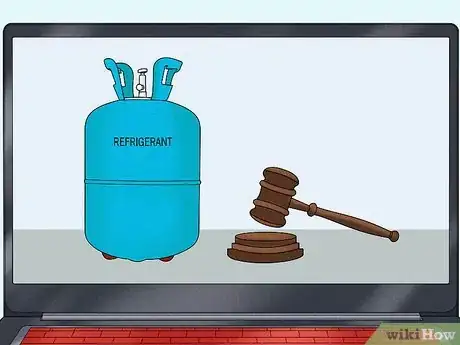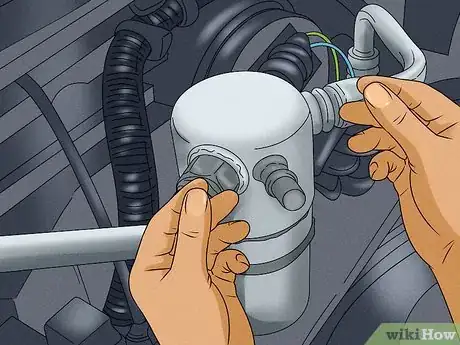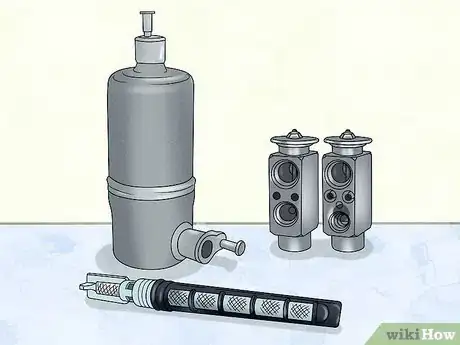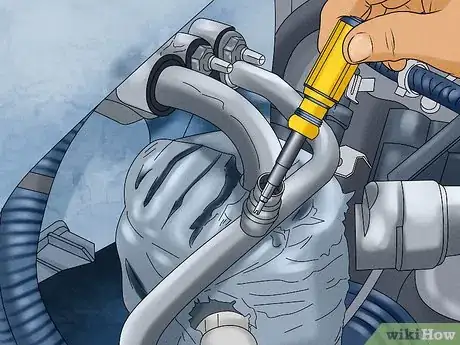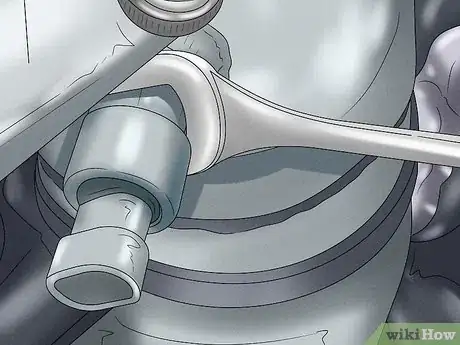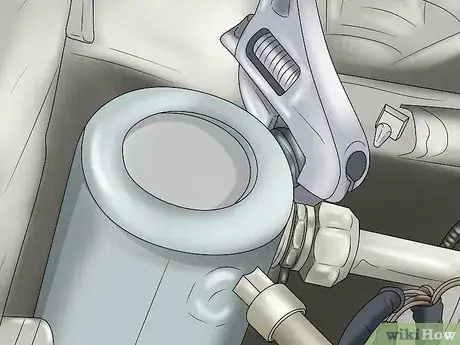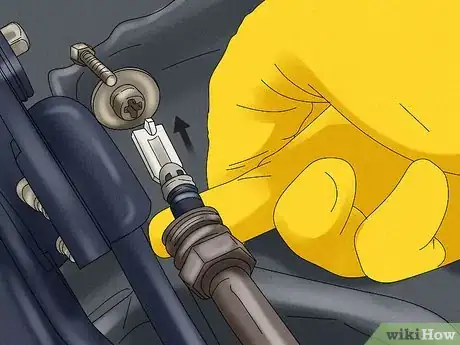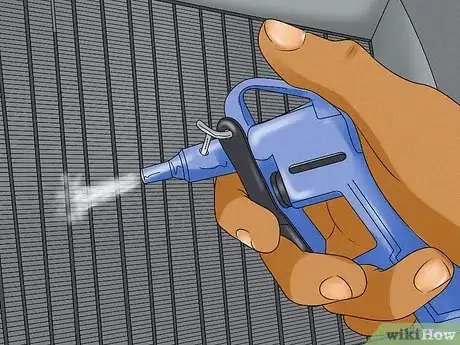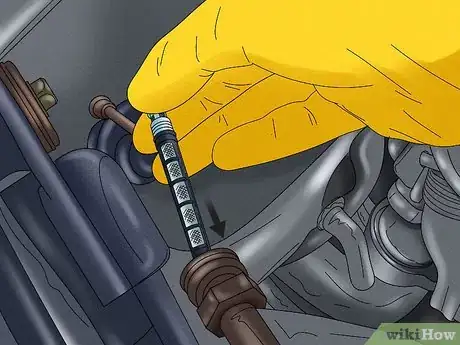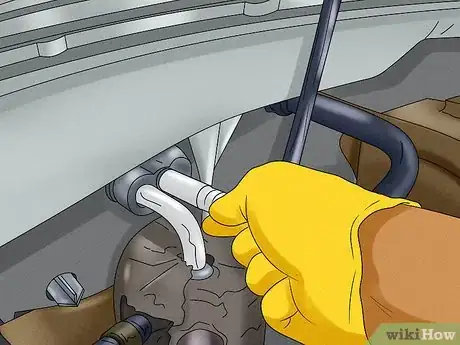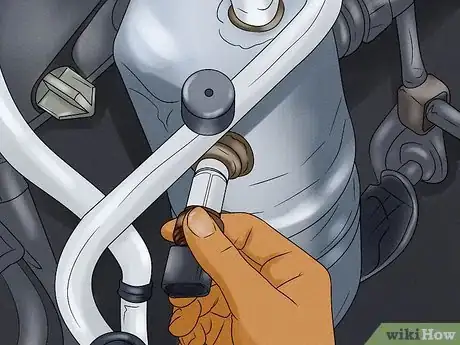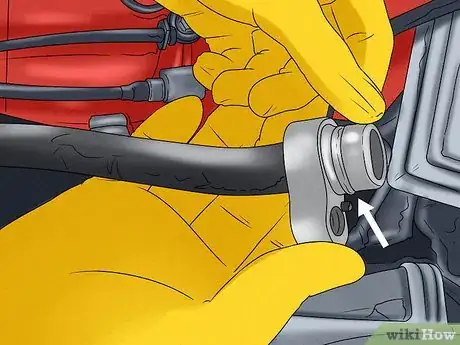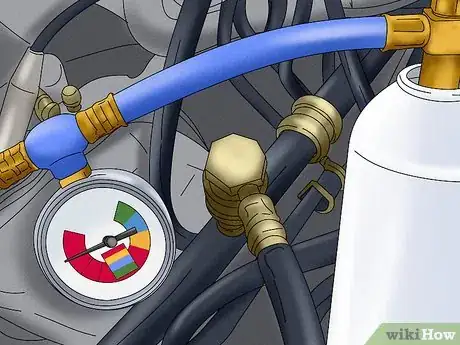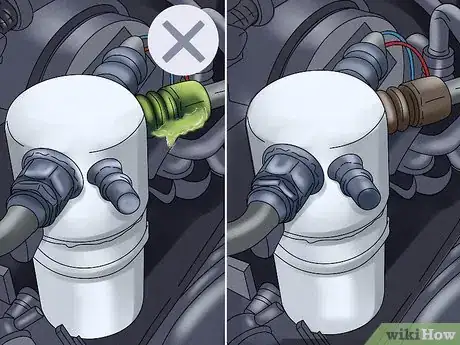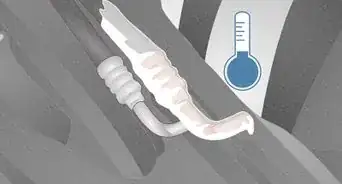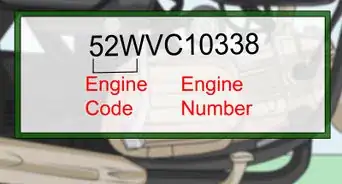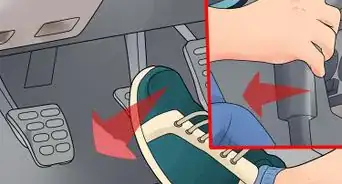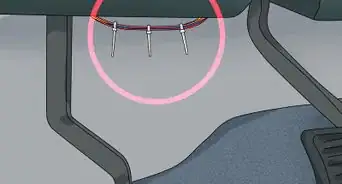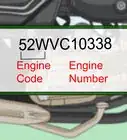X
wikiHow is a “wiki,” similar to Wikipedia, which means that many of our articles are co-written by multiple authors. To create this article, volunteer authors worked to edit and improve it over time.
This article has been viewed 36,356 times.
Learn more...
Air conditioning systems rely on an accumulator to store liquid refrigerant that did not expand into a vapor in the evaporator. This allows remaining liquid refrigerant to evaporate before continuing through the system and the device contains a desiccant to remove any moisture the system contains. Here are steps to help you change your accumulator as well as the orifice tube in your truck AC.
Steps
-
1Check your local laws to make sure it is legal for a non-certified individual to do this type of work. Since it will require purging any refrigerant, and purchasing replacement refrigerant, some jurisdictions may require a license to do the work.[1]
-
2Make sure changing the accumulator is necessary. Since the accumulator contains a desiccant to remove moisture from the refrigerant, if the system has been discharged and improperly recharged or needs recharging, changing the accumulator will help ensure the system works efficiently after recharging. It is also recommended the accumulator is replaced whenever a compressor is replaced as well.Advertisement
-
3Buy the needed parts. You can order a new accumulator from suppliers online, your local auto parts dealer, or from your vehicle manufacturer dealership parts store. Buy a replacement expansion valve (also known as an orifice tube) if you plan to replace it as well. The expansion valve is located in the refrigerant tubing at the bottom of the evaporator coils, and as with the accumulator, they can collect debris which impede their performance if the system has been compromised. Also, when changing the compressor, replacement of the expansion valve is usually a requirement for warranty coverage of the new compressor.
-
4Remove or discharge any remaining refrigerant from the AC system. It is better to have this done at a shop that has a refrigerant reclamation machine, but if the system is already discharged, this step can be skipped. Simply loosen the schrader valve on the low pressure (suction) charging fitting and listen for escaping refrigerant to determine if the system is still charged.[2]
-
5Remove the pressure sensor connector from the accumulator. This can usually be unplugged, but be careful, as there may be a clip that needs to be depressed or pried up to release it.
-
6Loosen the inlet and outlet couplings on the accumulator. Use the correct wrenches, and make sure the fittings do not allow the refrigerant lines to twist. You may to need two wrenches, one on the fitting and another on the compression nut that secures it to prevent damaging the refrigerant lines.[3]
-
7Loosen the clamp or support device that secures the accumulator in position. You can now completely remove the couplings and lift the accumulator out of the engine compartment. Make sure to keep it upright, as refrigerant oil and other nasty liquids may be in the bottom of it.[4]
-
8Loosen the fittings that join the high pressure refrigerant line near where it enters the bottom of the evaporator coil. Be sure to use a wrench on both nuts, since one is soldered onto the line and allowing it to twist will damage it. After the coupling is completely loosened, you can pull the two pipes apart.
-
9Look for a plastic (usually) tab just inside the tubing leading into the evaporator coil housing. You can grip this with a pair of needle nosed pliers to pull the expansion valve (again, also called the orifice tube) from the tube. Note that refrigerant oil may leak from the tube if any has accumulated in the evaporator coils.
-
10Blow out the evaporator coils with compressed air or compressed nitrogen to make sure no oil or debris is clogging them.
-
11Install the new expansion valve, the tapered end with an o ring should go in toward the evaporator coils. Check to see if the o ring in the refrigerant line coupling is still in good condition, then reattach the fittings that connect this pipe.[5]
-
12Install the new accumulator into its mounting bracket or support.
-
13Install the pressure sensor in the new accumulator. You can either buy a new one, or remove the one from the old accumulator and reuse it. If reusing your old one, it is generally a good idea to use a new seal or o ring when reinstalling it.[6]
-
14Install new o rings on the refrigerant line fittings on the accumulator, then reconnect the fittings and tighten them securely. You should now be able to either charge the system with new refrigerant or have it done at a licensed auto repair shop. Continue reading for basic instructions if you plan to proceed yourself.
-
15Use a vacuum pump to evacuate the air conditioning system so no moisture remains in it. Allow the pump to hold a vacuum for at least 90 minutes before recharging the system.
-
16Attach a refrigerant charging hose to a can of refrigerant, puncture the can (follow the instructions on the can if using 12 oz cans that require it), vent the air from the hose, and make sure the fittings are not leaking.[7]
-
17Start the engine and turn the AC on high cool and high fan. Open the charging valve and allow the refrigerant to enter the system. This can be a very slow process depending on the ambient temperature, do not rush it.
-
18Test all fittings for leak using a foaming soap mixture, clean up, and dispose of old parts and cleaning products safely.[8]
Advertisement
Warnings
- Venting refrigerant can be dangerous. Do not remove any fittings from a charged system.⧼thumbs_response⧽
- Do not over-tighten fittings with o ring seals, tighten them snuggly and check for leaks with a soap mixture after completing the project.⧼thumbs_response⧽
- It is generally a good idea to remove the battery cable when working under the hood of a vehicle, you will have to reconnect it when charging the system.⧼thumbs_response⧽
- Venting refrigerants may be illegal in your location.⧼thumbs_response⧽
Advertisement
Things You'll Need
- New accumulator and o rings
- Expansion valve
- Refrigerant (usually R-134a)
- Wrenches
- Cleaning supplies
References
- ↑ https://www.epa.gov/mvac/epa-regulatory-requirements-mvac-system-servicing
- ↑ https://carfromjapan.com/article/car-maintenance/how-to-discharge-car-ac-at-home/
- ↑ https://www.autoblog.com/2016/08/30/how-to-replace-an-ac-accumulator/
- ↑ https://www.autoblog.com/2016/08/30/how-to-replace-an-ac-accumulator/
- ↑ https://www.youtube.com/watch?v=RkKry31lk1E
- ↑ https://www.autoblog.com/2016/08/30/how-to-replace-an-ac-accumulator/
- ↑ https://www.2carpros.com/articles/air-conditioner-how-to-add-freon
- ↑ https://www.2carpros.com/articles/air-conditioner-leak-detection
About This Article
Advertisement
